Salam Tree - Spate Irrigation Network
advertisement
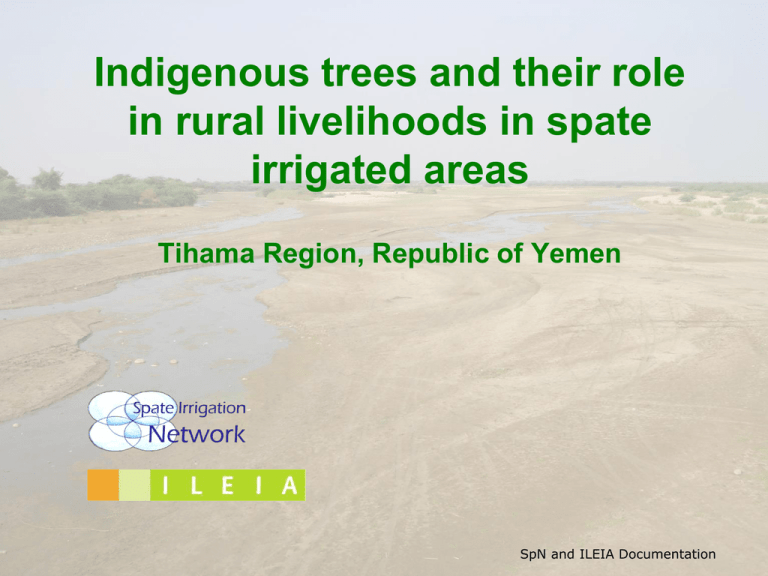
Indigenous trees and their role in rural livelihoods in spate irrigated areas Tihama Region, Republic of Yemen SpN and ILEIA Documentation Tihama zones and their native trees Zone 3 Zone I Red Sea Coast Arid coastal lowland RF: 50 - 100 mm/year EC >3 ds/m Stretch: 20 km Zone 2 Mid-land to mountainous RF: 300 to 400 mm/year Arid/semi-arid lowland RF: 100 to 200 mm/year EC:1-2 dS/m EC:< 0.7dS/m Stretch:30 km Stretch: 25 km Zone 1: Mangroove, Dome and Nehal trees Zone 2: Selam, Arack, Temariks and Haleg trees Zone 3: Daber and Sedr trees SpN and ILEIA Documentation Acacia Eherenbergiana Selam Tree SpN and ILEIA Documentation Some basic facts Most imporant & dominant Land coverage: 22,000 ha (2005) Resilient to drought: Grows well in areas with RF < 150 mm/year Moderately tolerant to salinity High regeneration capacity No dominant stem Life span: 10 to 15 years Tree height: 3 to 5 m Length of thorns: 8 cm SpN and ILEIA Documentation Major benefits Flowers Most loved by bees Selam Honey: Thick and dark Selam Honey Arguably the best Used for famous dishes: ‘Fata’ and ‘Bit Al-Sahan’, (bread with honey) Cost: USD 30/liter SpN and ILEIA Documentation Major benefits Leaves and thorns Best feed for goats Rich in proteins Effective in goat fattening SpN and ILEIA Documentation Major benefits Stem - wood Charcoal production: • Arguably the best • Lits quick and stay lit long • USD 5 per sack (about 20 kg) Keteran: • Fluid extracted from charcoal • Cure for animal (goat, sheep, camel) skin diseases SpN and ILEIA Documentation Charcoal production process Cut tree, trim leaves, and burn in a controlled manner, to remove thorns Pile thorn-free wood in good order Cover the piled wood with sorghum/millet residues left over by animals SpN and ILEIA Documentation Charcoal production steps Cover with metal sheet and then soil Ignite wood through small opening – let it burn for a week. After three days, fluid shed by the burning wood (Keteran) can be collected by inserting a pipe through the opening. Close opening with soil, allow 3 days for cooling Un-earth the woods, break them down and pack them in sacks Sell on site or deliver to the market SpN and ILEIA Documentation Words of caution and wisdom While charcoal prodution is source of livelihood for some, it should be conrolled: Selam Tree coverage has decreased from 44,000 ha in 1970 to 22,000 ha in 2005 (TDA records) “Iza Labu Sheger Selam, Labu Alnob, Labu Alasel, Labu alkenem, Labu Alakel” (if there is no Selam Tree, there are no bees, there is no honey, there are no goats, there is no food), words of the old namdic father seen in the picure SpN and ILEIA Documentation Zizphus spina-christ Sedr/Elb/Argh SpN and ILEIA Documentation Some basic facts Second to Selam, the most important tree Sparsely puputated - area coverage estimate:10,000 ha Sensitive to drought Requires 20 to 30 oC and 300 to 400 mm/year Sensitive to salinity Needs EC < 0.7 dS/m Life span: 20 to 25 years Height of tree: 5 to 10 m Small thorns: 1 to 2 cm SpN and ILEIA Documentation Major benefits Flowers: As loved by bee as that of Selam Elb/Sedr honey - Sedr honey: Thick and brownish • As good as - some say better than - that of Selam • Cost: USD 30/liter Fruits Tihama Apple Suplementary food Mild sugary taste SpN and ILEIA Documentation Major benefits Fruits Believed to cure kidney problems • Boil fruits • Thick juicy fluid will form • Filter the Juicy fluid - drink at least about 1 litre a day - you feel better in few weeks Leaves and branches: Favourite feed for Camel Natural shampoo: keeps hair fresh • Dry leaves • Grind and throughly mix with water to form thick green fluid • Wash hair with the thick green fluid SpN and ILEIA Documentation Major benefits Stem Strong, resistant to termite species Bed legs and frame Yemeni people enjoy gat (excitement plant) in such a bed Farm implements • Plough • Spade and hoe handle Fishing boats Jaafar Hassan Alawi Al-Jeffri, Director of Agriculture and Extension Department in his Eusha, a traditional hut where he enjoys Kat SpN and ILEIA Documentation Word of Eminence Sedr is the Selam tree to the highland inhabitants: it is the most important contributor to their livelihood Sedr, together with Selam, is a blessed tree in the Kuran (Jaafar Hassan Alawi Al-Jeffri, Director of Agriculture and Extension Department, TDA) SpN and ILEIA Documentation Silvadora persica Arack tree SpN and ILEIA Documentation Some basic facts Easy to uproot - its habitat is being constantly encroached by agricultural fields Endangered specie – estimate is less than 3,000 ha Resilient to drought: Fourishes with RF < 150 mm/year Slow at regeneration No dominant stem Life span: 10 to 15 years Tree height: 4 -6 m No thorns SpN and ILEIA Documentation Major benefits Roots Natutal tooth brush Raw material for tooth paste – export to Saudi Arabia 2 cm long root costs 30 Yemeni rial Fruits Green–unripe Redish when ripe Hot, spicy Supplied with almost every dish SpN and ILEIA Documentation Major benefits Tree as a whole Effective in stoping sand dunes Labelled as second best (first being Haleg) defence belt against sand dunes in the Munira village trial by the TDA Agricultural and Extension Department (see elaboration on slide 26) SpN and ILEIA Documentation Words of appreciation Profet Mohamed, may peace and prayers of Alah be upon him, said: “If I am not bothering you too much, I would ask you to brush your teeth (using Arack) five times – that is before each prayer time” SpN and ILEIA Documentation Balanites aegyptica Haleg SpN and ILEIA Documentation Some basic facts Native to mountainous areas 20 to 30 oC, 300 to 450 mm/year Performed well in the arid Munira Village (trial by Agriculture and Extension Department, TDA) > 35 oC, 100 to 200 mm/year Moderate regenation ability Moderately tolerant to salinity Dominant strong stem Life span: 20 to 25 years Maximum height: 5 - 10 m length of thorns: 5 – 8 cm SpN and ILEIA Documentation Major benefits Stem Strongest and heaviest (Sedr ranks 2nd) Best for traditional beds (slide 15) and traditional house poles Best for fishing boats (Sedr is second best) Leaves and branches Good Camel feed (Sedr is best, slide 14) Fruits Small egg shaped Suppemtary food for children High protein content One of the typical highland village huts, all poles are from Haleg SpN and ILEIA Documentation Major benefits Though native to highland areas, survived drought and proved to be the best sand dune defence in Munira Village (Arack is second best, slide 20) SpN and ILEIA Documentation Munira town gets life: thanks to Haleg & Arack Abondoned Munira Village houses due to sand dune 10 years back Notice 3 layers in the wall – top layer constructed in the past 3 years – still little buried by sand dune Revival of abondoned houses after 12 lines of Arak and Haleg defence against sand dune Task competed by TDA 3 years ago SpN and ILEIA Documentation Hyphaene thebaica Nehal (Date Palm) tree SpN and ILEIA Documentation Some basic facts Habitat: coastal area Irrigation: September to March Irrigation gift: 30 to 50 litres Interval: 3 to 4 weeks Fruit setting period: April to August Irrigation stops Population has dwindled 5 million trees (1970) 2 million trees (2005) Wadis reacch tree habitat less frequently now than 30 years ago Groundwater table: < 5 m (1970); > 40 m (2005) SpN and ILEIA Documentation Some basic facts Moderatelly tolerant to salinity Growndwater EC: 1.5 to 2 dS/m Moderately sensitive to drought Fruits become small and less fluidy if irrigation turn is 5 to 6 weeks No fruit setting if irrigation turn is 8 or more weeks Height of tree: 20 to 30 m Life span: 40 to 60 years SpN and ILEIA Documentation Major benefits Fruits Suplementary food: common in romodan (Isalamic fasting period) Date palm honey • Debs: general arabic term • Kitara:local Tihama arabic word – slow continous drops SpN and ILEIA Documentation Major benefits Complete construction of a village house Special Date Palm baskets 1 basket: USD 0.2 SpN and ILEIA Documentation Kitara traditional production system: Documentation in Riman Village Spread fruit and dry it Traditional • Simple spreading under date palm tree on sorghum/millet (left over from animal feed) layer • Manually spearate good and bad fruits – latter is used as fodder for cattle, goats, sheep, camel • Fruits dry naturally with air in 7 days Bad Date Palm fruit SpN and ILEIA Documentation Kitara traditional production system: Documentation in Riman Village Improved (TDA Extension) • Nylon covered case with various separation compartments – Better selection capacity of good or pure fruits • Windows for fresh air entry • Small motor to suck moisture • Drying period: 3 days Person operates moisture sucking small motor SpN and ILEIA Documentation Kitara traditional production system: Documentation in Riman Village Fill dried good fruits in a sack Pack sacks tightly on top of one another in a small windowless dark brick-walled room Temperature: > 40 oC Squeezed fruits at high temperature start dripping SpN and ILEIA Documentation Kitara traditional production system: Documentation in Riman Village Dripping black fluid flows on Concrete floar and is collected in a hole (traditional) Dripping black fluid is collected through a pipe into a container with a cloth filter on top (improved traditional) SpN and ILEIA Documentation Traditional Kitara production system The 170 to 200 sacks stay packed for 3 months Final product: Nice black Date Palm Honey Honey is usually collected in 5 liter jerican The honey is commonly sold in a 0.75 liter bottle 1 liter costs: USD 5 to 7.5 Father Hussien, expert in date-Palm Honey production in Riman Village SpN and ILEIA Documentation Word of Appreciation Date Palm is a major source of livelihood for coastal people – should be protected against wild cutting by unskilled hand-craft persons Date Palm honey is better than Almaraey (shepeherd) honey – honey produced when bees feed on flowers from variety of trees. The above are words of Father Hussien (seen on the right in bottom picture) – lots of thanks to him for explaining the production of date plam honey Date Palm Honey Factory house in Riman Village SpN and ILEIA Documentation Dome (coconut) Tree SpN and ILEIA Documentation Some basic facts Costal area plant, tolerant to salinity EC > 2.5 dS/m Poor in regeneration Land coverage significantly reduced 2 miilion trees in 1970 0.5 million in 2005 Relentlessly cut for various hand craft materials Groundwater (major source of water) table lowered from 2 - 5m (1970) to > 35 m (2005) Moderately tolerant to drought Dominat stem Height of tree: 15 to 30 m SpN and ILEIA Documentation Major benefits Fruits supplementary food Top hard and rough layer is removed by colliding two fruits or using a stone Layer beneath the cover is stif but delciious, it is eaten raw Interiror layer is a hard shell , childred use it for a swirling ball game. Leaves Various hand crafts • • • • Shopping baskets Prayer mat Bed sheets Sun protection hut SpN and ILEIA Documentation Major benefits Khel – Vinegar Salad dressing Soup Procedure to make Khel Make a cut at the juncture between stem and leaves Tie a container just below the cut to collect continously dripping thin liquid Add yeast to the liquid and let it stay for 40 days - it becomes strongly alcoholic with a flavour of vinegar Dilute it with an equal volume of water Usually sold in small bottles (0.3 l) for USD 5 per bottle Note: Actual Photo/Video documentation can be done in March/April when Khel is actually being produced SpN and ILEIA Documentation Tamarix Athel SpN and ILEIA Documentation Some basic facts Resilient to drought: RF < 150 mm/year Temperature > 35 oC Moderately tolerant to salinity Poor regeneration capacity Dominant stem Height of tree: 5 to 15 m Life span: 15 to 25 years SpN and ILEIA Documentation Major benefits Fence for agricultura area Perfect good looking hut roofs SpN and ILEIA Documentation Debora glabra Daber SpN and ILEIA Documentation Some basic facts Sensitive to drought RF: 300 to 450 mm/year Temperature < 30 oC Sensitive to salinity Very slow in regeneration Dominant stem Height of tree: 10 m to 15 m Lifespan: 50 to 70 years SpN and ILEIA Documentation Major benefits Stem Hole is drilled – store for farm implements and farmers’ lunch Hole can be easily drilled • Takes maximum 1 hour • Outer layer (3 to 5 cm ) is strong and stiff • Inner part is soft Fire wood Usualy dry old branches are collected SpN and ILEIA Documentation Word of significance Daber is persumably the oldest tree It is long living tree Have been playing under the shade of this tree since I was a kid. (words of the old father in the picture) Daber is a home away from home for farmers SpN and ILEIA Documentation Avicennia marina mangrove (Shura) SpN and ILEIA Documentation Some basic facts Inhabits the Red Sea Shores Very tolerant to salinity EC > 4 dS/m High regeneration capacity No dominant stem Max. plant height: 1 m SpN and ILEIA Documentation Major benefits Best feed for camel Habitat for migrant birds SpN and ILEIA Documentation With Special Acknowledgements to Jaafar Hassan Alawi Al-Jeffri Director, Agriculture and Extension Department Tihama Development Authroity REPUBLIC OF YEMEN SpN and ILEIA Documentation
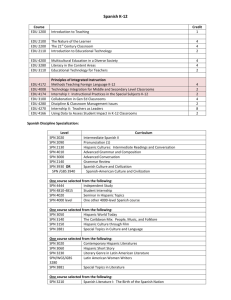
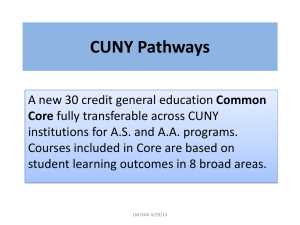

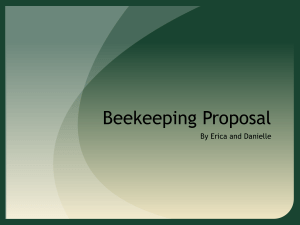
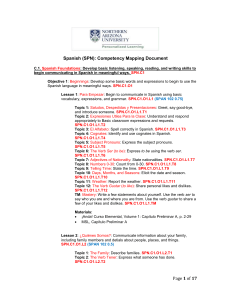
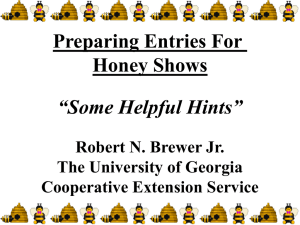
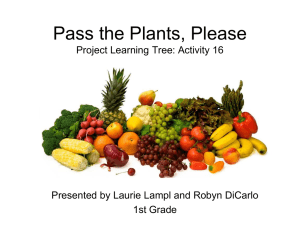
![Jefferson County, KY [Mission 5, Flight Experiment]](http://s2.studylib.net/store/data/005381659_1-6ff410f794c42188c46f63145dca8240-300x300.png)